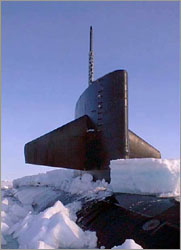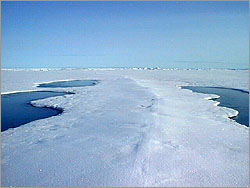
|
 |
 |
Part 2 | back to part 1 In addition to investigating this phenomenon, scientists aboard the SCICEX cruises have undertaken geophysical surveys of the Arctic seabed, including studying the little-known boundary between the North American and Eurasian tectonic plates. They've used sonars to determine how quickly sea ice forms and melts. (For a primer on sonar, see Sounds Underwater.) They've collected water samples and tested sea saltiness. And they've sampled minute crustaceans in the seafloor to determine if pollutants from industrialized countries to the south have contaminated this remote environment. "All of the marine and arctic disciplines are involved," says Dale Chayes, a sonar expert from Lamont Doherty who was one of five civilian researchers on the most recent cruise. "Not only mapping the seafloor with our sonars, but mapping the ice canopy with upward-looking sonars and measuring biological, chemical, and physical parameters of the Arctic in support of a very broad range of science programs." The logistical benefits to polar scientists are manifold. A submarine can do things no surface ship can. Sturgeon-class subs can travel at over 25 mph and are not impeded by sea ice, storms, or the need to refuel often. As long as the ocean is deep enough, they can go anywhere they want. They are quiet, which is good for sonar work, and extremely stable, which aids gravity and bathymetry studies. And they're a lot more comfortable than, say, a research camp out on the ice. Jay Ardai, another member of the August team who has long experience in the far north, told Chayes that "anytime I can go to the Arctic and take a hot shower once a day without having to make the water or generate the electricity is a real win." (To learn what it's like to work on a sub, see Life on a Submarine.)
Future prospects The last SCICEX cruise is slated for March 1999, when the USS Hawkbill once again heads into the frigid north. The Navy is about to retire its aging Sturgeon-class subs, which will shrink the submarine fleet to 50 from the 94 subs it boasted in the late 1980s. The downsizing might prove the death knell for SCICEX. "At least for the forseeable future, there will be fewer opportunities for dedicated cruises like the ones we've seen over the last four years," Anderson says. George Newton, true to the never-say-never attitude that helped him convince the Navy the first time around, continues to urge his former employer to fund additional cruises. "It's a very difficult situation to take much further at this point," he says. "But judging from my regular contact with the Navy, they are hopeful that they can continue the annual cruise at least into the year 2000."
It's a tall order. For one thing, who would run the sub? "I don't think it's realistic to have the civilian community operate a platform of the complexity of an attack submarine," says Chayes, who supports Newton's idea in principle. Even if the Navy continued to operate any sub it donated to science, there are enormous logistical issues to consider. For example, as Chayes notes, with a diesel-powered surface ship, you can enter virtually any port in the world and get food, fuel, spare parts—not so with a nuclear attack submarine. Plus, the bill to overhaul a Sturgeon-class sub for civilian science has been estimated at $50 to $200 million, with annual operating costs of perhaps $10 million. The Navy might have that kind of money, but does the science community? Newton is used to not convincing everyone right away. Perhaps while he pursues his latest dream, he'll just have to get thrown out of a few more offices. Peter Tyson is Online Producer of NOVA. Photos: (1,4,5,6) Courtesy of Dale Chayes; (2,3) U.S. Navy.
See Inside a Submarine | Can I Borrow Your Sub? Sounds Underwater | Life on a Submarine Resources | Transcript | Site Map | Submarines Home Editor's Picks | Previous Sites | Join Us/E-mail | TV/Web Schedule | About NOVA Watch NOVAs online | Teachers | Site Map | Shop | Search | To Print PBS Online | NOVA Online | WGBH © | Updated May 2002 |
 Dale Chayes (background) and Robin Muench, chief
scientist aboard SCICEX '98, get some work done in the
Hawkbill's modified torpedo room.
Dale Chayes (background) and Robin Muench, chief
scientist aboard SCICEX '98, get some work done in the
Hawkbill's modified torpedo room.
 The sail of the USS Hawkbill (SSN-666) pokes
above the polar ice during the August 1998 cruise.
The sail of the USS Hawkbill (SSN-666) pokes
above the polar ice during the August 1998 cruise.
 Will civilian scientists enjoy views of the North
Pole such as this one on future SCICEX cruises? The
program's fate now lies with the Navy.
Will civilian scientists enjoy views of the North
Pole such as this one on future SCICEX cruises? The
program's fate now lies with the Navy.